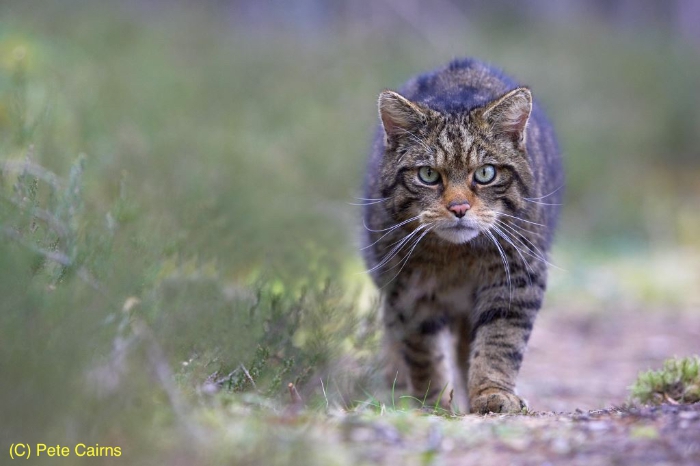Scientific name: Felis silvestris
Family: Felidae
Appearance: A tabby marked cat that is similar in appearance to a domestic cat, though slightly larger. Characteristics that distinguish wildcats from domestic cats are 1) A thick blunt-tipped tail with distinctive rings, 2) a dorsal line that extends down the back only as far the base of the tail, 3) four thick stripes down the nape, 4) two thick stripes on the shoulder, and 5) flank markings that consist mostly of stripes and not broken stripes or spots. The boldness of the markings can vary between individuals and season. Colour is brown with black markings. The fur on the back of the ears and nose may be ochre and the fur around the mouth can be pale though usually not pure white.
Size: Head and body 49-54 cm (female), 49-63 cm (male); tail 24-34 cm
Natural history: The current known range of the Scottish wildcat covers an area north of the Highland Boundary fault excluding islands. Within this range, wildcats are usually found in mixed habitats containing woodland or scrub and grassland habitats in which activity is concentrated around habitat edges. They are less commonly found on moorland. Providing there are suitable patches of forest or scrub cover, wildcats can be found in agricultural landscapes. In continental Europe, the wildcat in large parts of Central Europe, the Iberian peninsula and south-eastern Europe. Favoured prey are rabbit but rodents such as field vole, bank vole and wood mouse will be an important component of their diet, especially in the absence of rabbits. Hare may also be important in some areas. Their diet is varied and can also include birds, reptiles and even insects. While considered crepuscular (active at dawn and dusk) wildcats can be active both day and night, though they are likely to be more nocturnal in areas with greater human disturbance.
Wildcats are territorial, with females maintaining exclusive territories from other females and male territories covering those of several females. Male territories show more overlap with each other. Peak breeding season is winter, especially Dec-Mar. Gestation is 68 days and so litters are typically born Mar-Jun. Litters are usually 3-4 kittens which are weaned around 6-7 weeks. Kittens reach independence after 4-5 months, males are sexually mature after 9-10 months and females after one year. Usually only one litter is born each year, though if a litter fails the mother may have another. Males play no part in rearing the young.

(C) Peter Cairns

 English (United Kingdom)
English (United Kingdom)  Nederlands (nl-NL)
Nederlands (nl-NL)  Magyar
Magyar  Deutsch (Deutschland)
Deutsch (Deutschland)  Croatian (Hrvatski)
Croatian (Hrvatski)  Polski (PL)
Polski (PL)  Español (España)
Español (España)